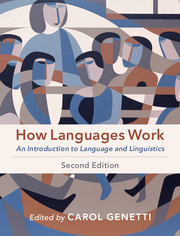Description
How Languages Work (2nd Ed., Revised edition)
An Introduction to Language and Linguistics
Author: Genetti Carol
A fully revised introduction to language in use, containing in-depth language profiles, case studies, and online multimedia resources.
Language: English
Subject for How Languages Work:
Approximative price 119.00 €
In Print (Delivery period: 14 days).
Add to cart
Publication date: 11-2018
704 p. · 19.3x25.2 cm · Hardback
704 p. · 19.3x25.2 cm · Hardback
Description
/li>Contents
/li>Biography
/li>
Language is a sophisticated tool which we use to communicate in a multitude of ways. Updated and expanded in its second edition, this book introduces language and linguistics - presenting language in all its amazing complexity while systematically guiding you through the basics. The reader will emerge with an appreciation of the diversity of the world's languages, as well as a deeper understanding of the structure of human language, the ways it is used, and its broader social and cultural context. Part I is devoted to the nuts and bolts of language study - speech sounds, sound patterns, sentence structure, and meaning - and includes chapters dedicated to the functional aspects of language: discourse, prosody, pragmatics, and language contact. The fourteen language profiles included in Part II reveal the world's linguistic variety while expanding on the similarities and differences between languages. Using knowledge gained from Part I, the reader can explore how language functions when speakers use it in daily interaction. With a step-by-step approach that is reinforced with well-chosen illustrations, case studies, and study questions, readers will gain understanding and analytical skills that will only enrich their ongoing study of language and linguistics.
List of figures; List of tables; Preface; Acknowledgements; List of glossing conventions; The book's approach; For students: how to use this book; Part I. Primary Chapters: 1. Introduction: language, languages, and linguistics Carol Genetti; 2. Phonetics: physical dimensions of speech sounds Matthew Gordon; 3. Phonology: organization of speech sounds Matthew Gordon; 4. Morphology: what's in a word? Marianne Mithun; 5. Word classes: evidence from grammatical behavior Carol Genetti; 6. Syntax: words in combination Carol Genetti; 7. Semantics: how language makes sense Michael Israel; 8. Pragmatics: inference for language Mira Ariel; 9. Discourse: language beyond the sentence Wallace Chafe; 10. Prosody: the music of language Wallace Chafe; 11. Language in the social world Mary Bucholtz and Lal Zimman; 12. Language change: the dynamicity of linguistic systems Marianne Mithun; 13. Language contact and areal linguistics Alexandra Y. Aikhenvald; 14. First language acquisition Patricia M. Clancy; 15. Second language acquisition Dorothy Chun and Jan Frodesen; Part II. Language Profiles: 1. Kabardian Matthew Gordon and Ayla Applebaum; 2. Goemai Birgit Hellwig; 3. Manange Kristine Hildebrandt; 4. Finnish Ritva Laury; 5. Nuuchahnulth (Nootka) Toshihide Nakayama; 6. South Conchucos Quechua Daniel J. Hintz; 7. Tsez Bernard Comrie; 8. Bardi Claire Bowern; 9. Lowland Chontal Loretta O'Connor; 10. Manambu Alexandra Y. Aikhenvald and Carol Genetti; 11. African-American English Anne H. Charity Hudley and Christine Mallinson; 12. Indonesian Robert Englebretson; 13. Seneca Wallace Chafe; 14. Akkadian Guy Deutscher; Glossary; References; Index; Appendix: IPA summary sheet.
Carol Genetti is a Professor of Linguistics and the Anne and Michael Towbes Graduate Dean at University of California, Santa Barbara. She is a specialist in Himalayan languages and in the documentation and description of previously undescribed languages. Her Grammar of Dolakha Newar (2007) was awarded the inaugural Von der Gabelentz book award from the international Association for Linguistic Typology. She has published numerous articles, especially on the syntax of clause combining in Tibeto-Burman languages, but also on phonology, morphology, syntax, discourse, typology, grammaticalization, grammar writing, and historical linguistics. In addition, Professor Genetti has a strong interest in the documentation and conservation of endangered languages. She was founding Director of the Institute on Field Linguistics and Language Documentation (InField/CoLang) and Chair of the Committee on Endangered Languages and their Preservation.
© 2024 LAVOISIER S.A.S.




